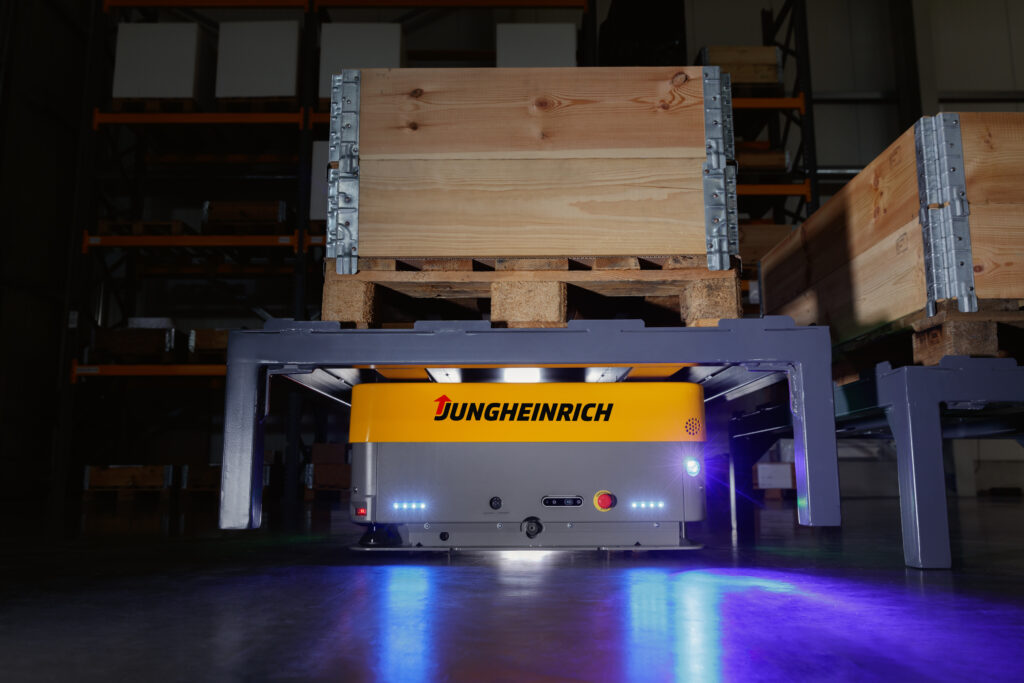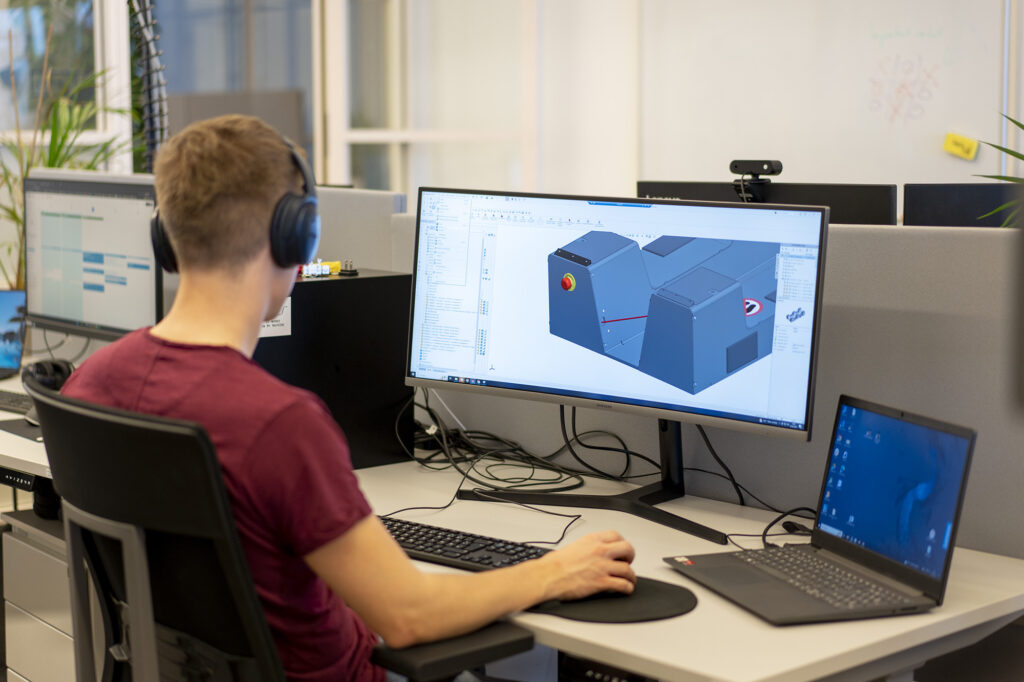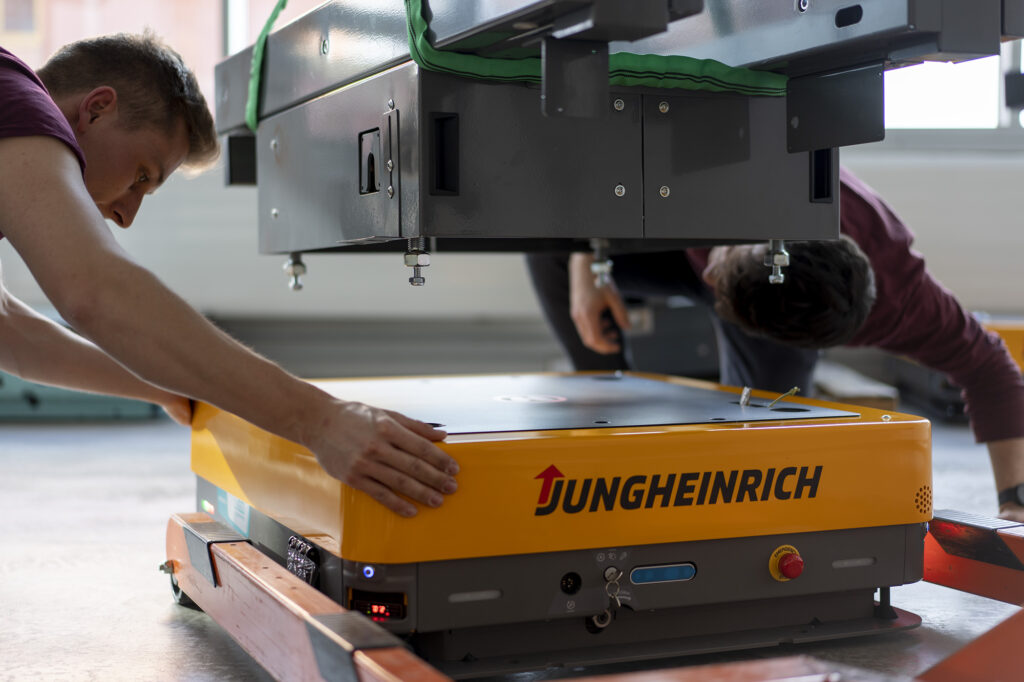In the world of Autonomous Mobile Robots (AMRs), the term “backpacks” refers to a specific range of attachments that assist the robots with object transportation. To better understand how these attachments empower our arculees, we sat down with Fabian Gebert, Robotics Engineer at arculus. Here are his insights into safety requirements, customisation options, and much more.
Understanding the basics of backpacks
Efficient material transport is essential in the increasingly demanding field of intralogistics. In this dynamic environment, backpacks empower AMRs to become agile material carriers, revolutionising operations and unlocking new levels of efficiency and productivity. As Robotics Engineer Fabian Gebert explains, “A backpack is an attachment for the arculee, and it’s used to detect and transport different objects.”
Without a backpack, the arculees rely on load carriers called “tables”. These large modules are particularly well-suited for applications where box transport is the primary focus and handover stations are not required. However, in the context of VNA (Very Narrow Aisle) warehouses, backpacks present a range of distinct advantages. Unlike tables, backpacks offer a compact design that facilitates agile manoeuvrability within confined spaces, thereby optimising the utilisation of the available area. They also incorporate advanced technology, ensuring secure and stable pallet transportation, reducing the risk of accidents or damage along the way.

The arculus backpack arsenal
The standard arculee S backpack is designed to transport the classic EURO and Industrial pallets (EPAL 1, EPAL 3, and HD 1208). Its integration with the robot creates a powerful combination that enables seamless transport of goods weighing up to 1 tonne. It also features an identification plate, which facilitates effortless recognition by the AMR’s system and allows for seamless integration into existing workflows.
The backpack also features light-barrier sensors that ensure accurate pallet detection and proper centring, minimising the risk of accidents and damage to goods and infrastructure. It also incorporates strong grip tape on the contact surfaces, which prevents pallets from slipping off even in demanding conditions. Both features work together smoothly, delivering a reliable and secure pallet handling process.

Backpack customisation at its core
Fabian explains that the customisation possibilities of backpacks at arculus are numerous: “Sometimes a customer already has some shells or environment restrictions, and then we just need to modify our prototypes in a way that fits their needs. But sometimes we get requests for entirely new and bespoke developments.”
This is exactly what happened when a customer requested a new addition to the arculus portfolio: the conveyor backpack. As the name suggests, the system incorporates a conveyor belt to enhance the pallet handling processes. Its primary purpose is to safely pick up Euro-Pallets from a fixed station and transport them to a conveyor station. There, the backpack utilises its own conveyor mechanism to transfer loads of up to 250kg, ensuring precise positioning and controlled movement.
The system incorporates two inductive sensors that facilitate alignment with the conveyor mechanism. To maintain safety, the backpack is equipped with end-stops that act as safeguards, preventing the pallets from being carried too far. Additionally, light barriers in the backpack ensure secure positioning of the pallet. The solution also features emergency stops on all sides, preventing unintended movement and providing very safe operation. With its seamless integration of a conveyor system, the solution streamlines pallet handling processes, improves workflow efficiency and contributes to overall operational effectiveness.

Testing and validation of backpacks
When it comes to ensuring the functionality and safety of the backpack before deployment, rigorous testing and validation procedures are essential. These tests encompass fully functional assessments, including evaluating the handover process, detecting the potential slippage of goods, assessing the alignment of loads, and determining the maximum cargo capacity.
As Fabian explains, the testing process involves various scenarios to evaluate the performance of the backpack. For instance, the team uses simulations to assess its functionality during conveyor pick-ups, its ability to detect and respond to obstacles, and its stability and safety during emergency stops. The goal is to ensure the backpack remains secure while providing optimal performance in real-world situations.

Metrics of success
In addition to rigorous testing, the team evaluates the effectiveness of backpacks using various performance metrics, such as cost, manufacturability, and operation time. For this, field evaluations and simulations play a crucial role in assessing the backpack’s performance. The results obtained in these procedures provide the engineers with valuable insights into improving the solutions’ efficiency. Operation time for example, measures the time required for an arculee equipped with the backpack to complete tasks such as load pick-up and drop-off. Other factors considered include reducing manufacturing costs, evaluating component feasibility, and meeting project deadlines.
“Testing and evaluating the backpack are crucial steps to ensure its safety and functionality.”
Fabian Gebert
Technical hurdles
The development of backpacks has various technical challenges, particularly when it comes to safety assurance. As Fabian explains, “Everything we do comes back to safety. Safely detecting a station, safely detecting the object on the backpack, safely detecting everything. That’s one of the major challenges we face during development.”
Integrating the backpack with the arculee’s control system also poses its own hurdles, particularly in software development, since communicating vital information between the backpack and the arculee’s control system is critical for proper functioning. For instance, if the backpack’s motor initiates movement while in a station, it must communicate this to the arculee, preventing it from engaging in any actions that could compromise safety. Effective communication and synchronisation between the backpack and the control system are essential for smooth operations.
Cross-team collaboration
The project’s multidisciplinary nature further adds complexity, requiring expertise in diverse fields such as electrical components, software integration, and mechanical design. Effective communication between teams plays a crucial role, as it ensures proper calibration and integration of all technical aspects and enables the development squad to approach challenges from various perspectives. By fostering effective communication and mutual understanding, the developers can overcome hurdles and ensure a smooth integration of the backpack with the arculee, ultimately leading to a successful and well-rounded product.

Packing it all up
The insights provided by Fabian Gebert offer a practical understanding of the arculee backpacks and their role in intralogistics. These attachments enable AMRs to become agile material carriers, offering distinct advantages over traditional load carriers. With features like accurate pallet detection, proper centring, and strong grip tape, the backpacks ensure secure and efficient pallet transport. Customisation options and rigorous testing further highlight arculus’ commitment to delivering safe and functional solutions. By integrating advanced technology and fostering cross-team collaboration, arculus enhances pallet handling processes and contributes to operational effectiveness in diverse industrial environments.